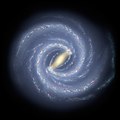| Ursa Minor Dwarf | |
|---|---|
 Ursa Minor Dwarf | |
| Observation data (J2000 epoch) | |
| Constellation | Ursa Minor |
| Right ascension | 15h 09m 08.5s [1] |
| Declination | +67° 13′ 21″ [1] |
| Redshift | −247±1 km/s [1] |
| Distance | 200 ± 30 kly (60 ± 10 kpc) [2] [3] |
| Apparent magnitude (V) | 11.9 [1] |
| Characteristics | |
| Type | E [1] |
| Apparent size (V) | 30′.2 × 19′.1 [1] |
| Notable features | Satellite galaxy of Milky Way |
| Other designations | |
| UGC 9749, [1] PGC 54074, [1] DDO 199, [1] UMi Dwarf [1] | |

The Ursa Minor Dwarf is a dwarf spheroidal galaxy, discovered by A.G. Wilson of the Lowell Observatory, in the United States, during the Palomar Sky Survey in 1955. [4] It appears in the Ursa Minor constellation, and is a satellite galaxy of the Milky Way. The galaxy consists mainly of older stars and seems to house little to no ongoing star formation. Its centre is around 225,000 light years distant from Earth. [5]
